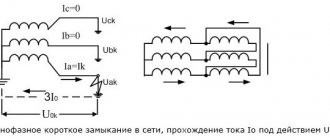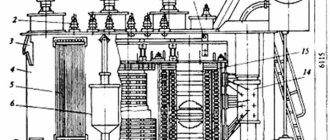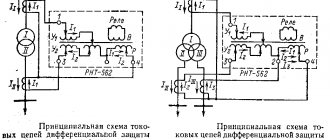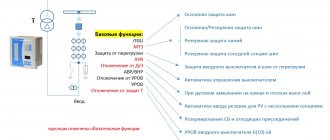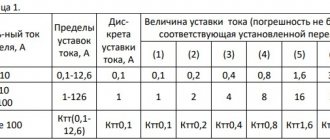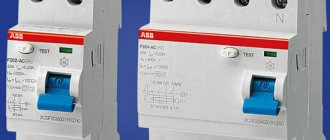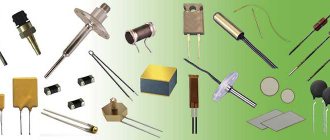Today, to protect electrical wiring in our houses and apartments, the usual circuit breakers, RCDs or differential circuit breakers are enough for everyone.
However, in the near future, another device may be added to them, which is still unfamiliar to the average consumer, but is increasingly being introduced into our lives, both at the voluntary level and at the legislative level. At least the regulatory framework goes in this direction (GOST R50571.4.42-2017).
Simply put, they are called spark-proof or arc-protective devices. For now, their installation is just a recommendation, but in the coming years everything could change dramatically. This happened in the initial stages of RCD implementation.
These devices have many abbreviated names:
- UZIS - spark protection device
- AFDD - that's what it's called in Western countries
- AFCI is an abbreviation used in the USA
- UZDP - arc flash protection device
Which of the names is more correct? According to GOST IEC 62606-2016, it would be more correct to call it an ultrasonic transducer, although among the people the very first one, ultrasonic sensor, has become more popular.
Let's take a closer look at what they are and why they are needed.
Causes of fire in electrical wiring
These devices detect the presence of a spark in the wiring and de-energize it. The main cause of fire in houses is not some kind of current leakage, from which fire-fighting RCDs are designed to protect (with a leakage current of 100-300 mA) and not even short circuits.
If the electrical installation is carried out correctly, the cross-section and rating of the machine are selected correctly, then the risk of fire occurring and spreading is minimal.
Most often, fires occur due to sparking wiring or an arc that occurs due to poor contact.
We can list 9 main reasons for these phenomena:
- mechanical damage to the cable
- loose contact, which appears not only after a long period of use, but also due to the use of the wrong tool
- crushed cable
- damage by rodents to hidden wiring behind hollow walls due to lack of protection with corrugated hose
- damage to external insulation and lack of basic protection in the form of electrical tape or thermal tube
- aging of insulation, which is promptly detected by special devices
- factory defect of a cable not manufactured in accordance with GOST
- poor contact (due to a bad socket or inappropriate plug)
- twisting of copper and aluminum
Moreover, sparking can occur even on a seemingly solid wire or cable. It was enough to make too sharp a bend during installation or accidentally place something heavy on it.
In principle, these problems and causes have been known for a long time, but the technology did not exist until the late 90s. They were first used in power grids in the USA and Western countries.
They are most widespread in wooden frame-type houses, where all wires, without any corrugations or pipes, are laid openly through flammable partitions.
Of course, such protection is not a panacea and will not save, for example, from elementary contact heating. If your plug does not spark in the socket, but only heats up, or the contact at the junction of the copper and aluminum wiring has oxidized, which also leads to heating, then a fire cannot be avoided and arc-protective devices will not help here.
Although, again abroad, they are gradually beginning to introduce sockets with built-in thermal protection. If they overheat, they automatically turn off.
True, such sockets are not required for installation anywhere else, even in the USA, and are installed on a voluntary basis.
SPD classes
Today, all surge voltage devices are divided into three classes. And each of them plays its role.
The first class module dampens the main impulse; it is installed on the main input panel.
After the largest overvoltage has been extinguished, the residual impulse is taken over by a class 2 SPD. It is mounted in the distribution panel of the house.
If you do not have a Class I device, there is a high probability that the entire impact will be taken by the II module. And this could end very sadly for him.
Therefore, some electricians even discourage customers from installing impulse protection. Motivating this is that since you cannot provide the first level, then you should not spend money on it at all. There will be no point.
However, let's see what not a familiar electrician says about this, but the leading company for lightning protection systems, Citel:
That is, the text directly states that class II is mounted either after class 1, or AS AN INDEPENDENT DEVICE.
The third module directly protects a specific consumer.
If you do not want to build all this three-stage protection, purchase SPDs that are initially designed to work in three zones 1+2+3 or 2+3.
Such models are also produced. And they will be the most universal solution for use in private homes. However, their cost will certainly scare off many.
Operating principle of spark protection devices
How does the spark protection device, which is located in the electrical panel at the entrance to the house, see the sparking of the wire in the farthest socket in the bedroom or living room? What magic is used here?
Of course, there is no magic here, everything is based on the laws of physics. The device mainly monitors the spectrum of the current passing through it.
When sparking begins anywhere in the electrical wiring circuit, firstly the sinusoid is distorted and it becomes jagged. The current and voltage begin to change abruptly. Interference occurs.
However, if the protection were configured to monitor only these parameters, there would be a lot of false positives. This is exactly what the very first copies sinned with.
Therefore, the latest high-quality ultrasonic sensors or ultrasonic sensors analyze a lot of parameters:
- size
- form
- polarity
- duration
- and the pace of the jumps
Manufacturers of spark and arc protection devices are required by the GOST standard to have the following three main tasks:
- analyze the current, and at the same time make sure that its source is the arc, and not the payload
The device has the right to ignore and let through anything that sparks with an arc current of less than 2.5A.
- find out how dangerous this arc is by its power
After all, simply plugging a plug into a socket also causes sparking. But nothing should be disabled.
- if the first two tasks are successfully solved and the current is detected, then it must be broken in a given time
Uzis to the yard
As it turns out, things are not so simple in the YARD either. When it is triggered by sparking from an old drill, it’s understandable. But when the new Ferm FBH-620K rotary hammer turned off twice during an hour of work, I was completely disappointed in such a protection device! Moreover, it works both on key switches and when turning on/off the load through the plug connector (not always, but it turns off). A separate outlet will save you in some cases, but how can you know in advance what will trigger it?! You won’t always pull an extension cord from a separate one if there are already sockets nearby! In general, a hassle, according to the law of meanness, is triggered at the most inopportune moment. I don’t know what to do anymore, I’ll probably remove it completely.
Types and types of AFDP
With all this, GOST does not determine exactly how to do this. Each manufacturer solves the problem in its own way and issues appropriate patents.
- Meander UZM 51MD
- AFDD Eaton
- UZIS-S1-40 Ecolight
- Siemens 5SM AFD
- ABB S-ARC1
- Hager
Only when all factors are combined does the protective device determine that an arc has appeared in the circuit and turns it off.
If the pulses in the network are less than the specified amplitude, then this is considered not dangerous and the device does not respond.
Unlike the voltage relays we are used to, there are no manual settings on such arc-protective circuit breakers.
In voltage switches, you can adjust the triggering both at the upper and lower limits. Here, all parameters are set at the manufacturer’s factory.
Of course, the very first such specimens still have errors and false positives. The technology cannot be called fully developed.
However, most of the blunders have already been eliminated. For example, an ordinary vacuum cleaner, blender or drill, when turned on, can generate a certain wave characteristic similar to an arc. An arc also occurs when the stove is electrically ignited.
Any brushed power tool sparks, especially if its brushes are already worn out enough. Not to mention the initial inrush current.
Manufacturers take all these operating points into account and there are fewer and fewer false alarms in high-quality models.
How quickly should these arc flash detection devices respond? Everything here depends on the voltage and rating of the arc current.
According to the requirement of the IEC 62606 standard, at a current of 10A, the response time should not exceed 0.25 seconds.
Here is a table of all values:
Purpose
These devices perform several functions at once:
- Quick shutdown of equipment and electrical appliances in single-phase networks in cases where voltage parameters exceed established limits. In the same way, the protection is triggered when the neutral conductor breaks.
- Protection of equipment and other connected loads at a given facility from the influence of pulse-type voltage surges resulting from the operation of nearby sources of such pulses. In this case, all devices and electronic equipment are reliably protected from destruction and possible fire.
Protective devices fully monitor the voltage state and prevent possible triggering causes. After shutting down in emergency mode, the UZM protection device turns on automatically when the mains voltage returns to normal. This switching occurs after a certain delay time, configurable by the user.
Such protective equipment can be used for any configuration of electrical networks - TN-C, TN-S, TN-CS, TT. At the same time, its use does not at all cancel traditional means of protection - automatic machines, RCDs and others.
In addition to protection, UZM-50Ts reduces inrush currents when connecting capacitive loads. In this case, the relay contacts close at zero mains voltage when it passes through the neutral conductor.
How to find the place where it sparks and why the arc protection knocks out
Let's say your device worked and everything turned off. How to find the place where the arc occurred and sparks appeared? If you have a two-story mansion with fifty outlets, where should you go first and how to find out this order?
Your electrical panel will help you here. The more groups and machines it has, the better.
Each machine is responsible for a specific room or zone in the house. Disable them all en masse, and then turn on the AFDD.
Then, one by one, you begin to turn on the circuit breakers. Moreover, after turning on each machine, you wait at least 10 seconds and only then move on to another.
Keep in mind that all devices that were working before must be connected in the circuit. In addition, they must be under load, not idling. Otherwise, at currents up to 2.5A, the arc protection device may not work.
When the faulty line is turned on, the arc protection must turn it off again. Thus, you will identify a problem area or group. Let's say this is a kitchen.
You send your wife there to watch, while you restart the machine. Visually or by sound it will be possible to determine the location of the spark.
What if you still can’t see or hear anything? Then proceed as follows. Begin to unplug all devices on this line one by one.
If the AFSD still trips, then the reason is in the wiring itself, and if not, then one of the disconnected devices or a specific outlet is to blame.
Plug another device into this outlet and see what changes.
Method of finding a sparking place
Sparking is a harbinger of fire. Therefore, if the spark protection device constantly trips, then you need to look for the location of the unstable contact
Attention should be paid to the following nodes:
- Distribution boxes. Open, look, look for the burning smell. If you turn off the voltage in the apartment, then you can test the twists for heating.
- Sockets, extension cords, plugs. They also get hot and smoke when heated.
- Apartment distribution board. The screws on the terminals of circuit breakers are often loose. As a result, poor contact with the wires and sparking occurs. Terminal blocks on automatic machines should be periodically tightened, but without fanaticism.
https://youtube.com/watch?v=ZYsLuwLibZY
Separately, the main signs of sparking contacts should be noted:
- crackling at the spark site;
- the smell of burning;
- overheating of connections;
- smoke;
- blinking light;
- crackling in the speakers of acoustic systems;
- light, sparks.
The operating principle of the AFDD is based on monitoring the state of voltage and current in the electrical wiring. Monitoring these parameters allows you to detect the appearance of sparks and arcs in strands and terminal blocks at an early stage and turn off the power supply to the apartment. As a result, the risk of wiring fires or damage to expensive consumer electronics is significantly reduced.
The arc protection device most closely resembles a voltage relay. Both protection devices have an upper and lower operating voltage limit. However, the AFDD has broader functionality, that is, it can detect sparks in twists and other unreliable burning contacts.



